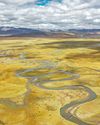
“We have never believed that people are separated from Nature. Walruses are the walrus people, whales are the whale people, and the orca is our most honourable animal. When a hunter dies, his soul passes into the killer whale.”
Igor Makotrik speaks slowly, measuredly, as if every word carries considerable weight. He is 62, but like many Yupik, he looks younger. Igor heads the Novoye Chaplino community of sea hunters. There are about 400 residents in the village, and a community of 15 hunters provides the entire village with food.
It’s still mid-August, but the yellow and red colours of the tundra make it clear that winter is very close. Gloomy rain clouds crouch over hills decorated with stripes of the previous year’s snow. For hundreds of kilometres around, there is not a single tree, nothing that is a barrier to the piercing cold wind. The air temperature during the day is about five degrees Celsius; the water temperature is a degree above freezing. This is what summer in Chukotka is like.
A diesel generator hums continuously at the edge of Novoye Chaplino, producing electricity for the entire settlement. There is a boiler on the opposite side of the village.
According to northern custom, heating mains are not buried but run along the ground, parallel to the streets, in concrete boxes. In the alleys, wooden walkways are built across these concrete elevations. The heating is never turned off here, even in summer.
CRAFTING KAYAKS THE TRADITIONAL WAY
There is no heating in the workshop of Timofey Ayanto, a master carpenter. Everybody in Chukotka knows Timofey; he has long since forgotten how many baidarkas and sleds he has made for the hunters.
Denne historien er fra AG 162-utgaven av ASIAN Geographic.
Start din 7-dagers gratis prøveperiode på Magzter GOLD for å få tilgang til tusenvis av utvalgte premiumhistorier og 9000+ magasiner og aviser.
Allerede abonnent ? Logg på
Denne historien er fra AG 162-utgaven av ASIAN Geographic.
Start din 7-dagers gratis prøveperiode på Magzter GOLD for å få tilgang til tusenvis av utvalgte premiumhistorier og 9000+ magasiner og aviser.
Allerede abonnent? Logg på

A Spectrum Of Scarlet: The Symbolic Red Of Asian Flags
A common thread that unites many Asian flags is the prominent use of red, a colour rich with symbolism

Curry: A World of Flavour, Tradition, and Culture
From its humble beginnings in India, the concept of "curry" has evolved into a culinary language understood around the world

The Power Of Asian Red Fruits - Discover 10 Nutrient-Rich Gems Of The East
In the vast tapestry of Nature, Asia has gifted the world an array of unique and vibrant fruits, particularly those in shades of red. These scarlet-hued gems, packed with flavour and nutrients, not only add a burst of colour to your plate but also carry valuable health benefits. From antioxidant-rich goji berries to the exotic dragon fruit, let's explore some of the most popular red fruits from Asia and discover why they should be part of your diet.

Bhutan: A World Of Its Own
With its majestic monasteries, red-robed monks, charming rural villages, and vibrant festivals, the Kingdom of Bhutan is a Himalayan paradise that promises an enriching travel experience like no other

Take The Red Pill
From the vermilion torii gates of Japan to the famed rust-hued walls of India's Agra Fort, the burgundy robes of Burmese monks to scarlet chillies drying in the Bangladeshi sun, red is the quintessential colour of Asia.

70 Days for Our Land Animals
Raising awareness about conservation, the environment, and the land-dwelling species of the world

The Red Panda
Meet the elusive guardian of the Eastern Himalayas

Revealed Doctor Yellow
Japan Railways' special lemony Shinkansen is a rare sight to behold

The Mighty Yellow
Over 5,000 kilometres long and flowing through nine provinces and autonomous regions, the Yellow River is China's second largest, after the Yangtze, while its basin is deemed the cradle of Chinese civilisation

Wildlife Big Yellow Beauty
The popular "amelanistic" form of the Burmese python is considered among the most beautiful snakes - if that's your sort of thing